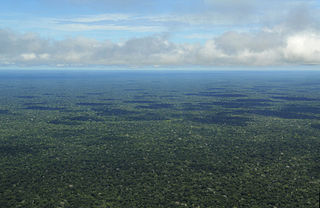
A forest is an area of land dominated by trees. Hundreds of definitions of forest are used throughout the world, incorporating factors such as tree density, tree height, land use, legal standing, and ecological function. The United Nations' Food and Agriculture Organization (FAO) defines a forest as, "Land spanning more than 0.5 hectares with trees higher than 5 meters and a canopy cover of more than 10 percent, or trees able to reach these thresholds in situ. It does not include land that is predominantly under agricultural or urban use." Using this definition, Global Forest Resources Assessment 2020 found that forests covered 4.06 billion hectares, or approximately 31 percent of the world's land area in 2020.

The Amazon rainforest, also called Amazon jungle or Amazonia, is a moist broadleaf tropical rainforest in the Amazon biome that covers most of the Amazon basin of South America. This basin encompasses 7,000,000 km2 (2,700,000 sq mi), of which 5,500,000 km2 (2,100,000 sq mi) are covered by the rainforest. This region includes territory belonging to nine nations and 3,344 formally acknowledged indigenous territories.

Forest Peoples Programme (FPP) advocates an alternative vision of how forests should be managed and controlled, based on respect for the rights of the people who know them best. FPP works with forest peoples in South America, Africa, and Asia, to help them secure their rights, build up their own organisations and negotiate with governments and companies as to how economic development and conservation are the best achieved on their lands.
The Green Belt Movement (GBM) is an indigenous grassroots organization in Kenya that empowers women through the planting of trees. It is one of the most effective and well-known grassroots organisations addressing the problem of global deforestation. Professor Wangari Maathai established the organization in 1977 under the auspices of the National Council of Women of Kenya (NCWK). GBM's successes in forest conservation, education, and women's economic empowerment have gained the organisation worldwide acclaim. It is also noted for its advocacy of human rights, democratisation of access to public lands, and environmental justice issues such as the role of women's traditional ecological knowledge in addressing environmental degradation and desertification.

The Center for International Forestry Research (CIFOR) is a non-profit scientific research organization that conducts research on the use and management of forests with a focus on tropical forests in developing countries. CIFOR, which merged with World Agroforestry on Jan. 1, 2019, is the forestry and agroforestry research center of the Consultative Group on International Agricultural Research (CGIAR), a network of 15 research centers around the world that focus on agricultural research for sustainable development, working closely with governments and other partners to help develop evidence-based solutions to problems related to sustainable agriculture and natural resource management.

The Congo Basin is the sedimentary basin of the Congo River. The Congo Basin is located in Central Africa, in a region known as west equatorial Africa. The Congo Basin region is sometimes known simply as the Congo. It contains some of the largest tropical rainforests in the world and is an important source of water used in agriculture and energy generation.

The Rainforest Foundation Fund is a charitable foundation founded in 1987 and dedicated to drawing attention to rainforests and defending the rights of indigenous peoples living there.

The World Rainforest Movement (WRM) is an international initiative created to strengthen the global movement in defense of forests, in order to fight deforestation and forest degradation. It was founded in 1986 by activists from around the world.

The Prince's Rainforests Project (PRP) was set up in the UK in 2007 by Charles, Prince of Wales following reports from leading climate change experts, including the Intergovernmental Panel on Climate Change, to promote awareness of the urgent need to take action against tropical deforestation. The Prince of Wales has long been concerned about climate change and about how destruction of the world's rainforests contributes to rising temperatures and sea levels.

Cool Earth is a UK-based international NGO that funds Indigenous communities to protect endangered rainforests in order to combat the climate crisis and protect ecosystems.
Embobut is one of the administrative wards for the Marakwet East Constituency in Elgeyo-Marakwet County, Kenya. The area contains one of two major drainage basins for Elgeyo-Marakwet County, referred to locally as a "water towers". The other water tower in Elgeyo-Marakwet County is Cherangani Hills. Embobut supplies Eldoret town and its environs with water. Collectively the Embobut and Cherangani Hills water towers also supply water to the Kerio River, which flows through the Cheploch Gorge in Baringo to Lake Turkana via the Turkwel Gorge.

Rainforest Foundation US is a non-profit NGO working in Central and South America. It is one of the first international organizations to support the indigenous peoples of the world's rainforests in their efforts to protect their environment and fulfill their rights to land, life and livelihood.
The Rainforest Foundation UK (RFUK) is a non-profit NGO working in Africa and South America. It is one of the first international organizations to support the indigenous peoples of the world's rainforests in their efforts to protect their environment and fulfill their rights to land, life and livelihood. The Foundation aims to protect rainforests by securing the land rights of indigenous peoples and other forest-dependent communities. It also campaigns internationally on issues such as industrial logging, climate change, agricultural expansion and nature conservation.

Deforestation in Borneo has taken place on an industrial scale since the 1960s. Borneo, the third largest island in the world, divided between Indonesia, Malaysia and Brunei, was once covered by dense tropical and subtropical rainforests.

Deforestation in the Democratic Republic of the Congo (DRC) is an environmental conflict of international importance. Most of the deforestation takes place in the Congo Basin, which holds the second largest rainforest of the world after the Amazon. Roughly fifty percent of the remaining rainforest in the Congo Basin lies within the boundaries of the DRC.

Forest restoration is defined as “actions to re-instate ecological processes, which accelerate recovery of forest structure, ecological functioning and biodiversity levels towards those typical of climax forest” i.e. the end-stage of natural forest succession. Climax forests are relatively stable ecosystems that have developed the maximum biomass, structural complexity and species diversity that are possible within the limits imposed by climate and soil and without continued disturbance from humans. Climax forest is therefore the target ecosystem, which defines the ultimate aim of forest restoration. Since climate is a major factor that determines climax forest composition, global climate change may result in changing restoration aims. Additionally, the potential impacts of climate change on restoration goals must be taken into account, as changes in temperature and precipitation patterns may alter the composition and distribution of climax forests.
The Indigenous Environmental Network (IEN) is a coalition of indigenous, grassroots environmental justice activists, primarily based in the United States. Group members have represented Native American concerns at international events such as the United Nations Climate Change conferences in Copenhagen (2009) and Paris (2016). IEN organizes an annual conference to discuss proposed goals and projects for the coming year; each year the conference is held in a different indigenous nation. The network emphasizes environmental protection as a form of spiritual activism. IEN received attention in the news as a major organizer of the fight against the Keystone Pipeline and the Dakota Access Pipeline in the Dakota Access Pipeline protests.
Rainforest Foundation Norway (RFN) is a non-governmental organization (NGO) working to protect the world's rainforests and to secure the legal rights of their inhabitants. It is one of the largest rainforest organizations in the world, and collaborates with around 70 local and national environmental, indigenous and human rights organizations in 7 rainforest countries in the Amazon region, Central Africa and Southeast Asia. The organization works to support people in securing their rights and increase people's level of commitment to rainforest protection; to prevent policy and business interests from contributing to the destruction of the rainforest; and to consolidate policy and practice that serve to protect it. RFN engages in advocacy work in key international processes concerning rainforest issues.
Catherine Potvin is a tropical forest ecologist and professor at McGill University in the Department of Biology. Her scientific research studies climate change, carbon cycling, and biodiversity in tropical rainforests with an additional focus on community empowerment and climate change policy. She was the first woman to receive the Miroslaw Romanowski Medal from the Royal Society of Canada, in recognition of her "significant contributions to the resolution of scientific aspects of environmental problems". In addition to her scientific research, she works on sustainable development with indigenous communities in Panama and on policy as a former UN climate change negotiator for Panama and leads climate change initiatives in Canada.












